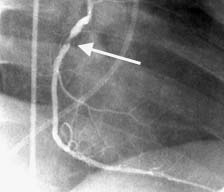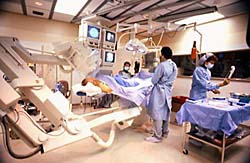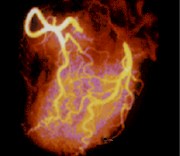Related terms: angiogram, cardiac angiography, coronary angiogram
|

|
| Angiogram: arrow indicates a blockage in a coronary artery
|
Angiography is an x-ray technique in which dye is injected into the chambers of your heart or the arteries that lead to your heart (the coronary arteries). Doctors can then measure the blood flow and blood pressure in the heart chambers and see if the coronary arteries are blocked.
How does it work?
Doctors perform a cardiac catheterization procedure in which a long, thin tube (called a catheter) is put into an artery in the leg and threaded into the heart. Once the catheter is in place in the heart, a dye is injected through the catheter and into the heart. The dye helps doctors see how the heart chambers and the coronary arteries are working. The movement of the dye through your heart and coronary arteries is recorded as an angiogram and viewed on a television monitor.
What should I expect?
Do not eat or drink anything after midnight the night before your test. If you have diabetes, you should talk to your doctor about your food and insulin intake, because not eating can affect your blood sugar levels.
Talk to your doctor about any medicines (prescription, over-the-counter, or supplements) that you are taking, because he or she may want you to stop taking them before the test. Also, it may be helpful if you make a list of your medicines and bring it with you to the procedure, so that the doctors know exactly what you are taking and how much. You will most likely have blood tests, an electrocardiogram, and a chest x-ray taken before the procedure.
|

|
|
Catheterization Laboratory
|
Once you are in the catheterization laboratory, you will see television monitors, heart monitors, and blood pressure machines. You will lie on an examination table, which is usually near an x-ray camera.
Small metal disks called electrodes will be placed on your chest. These electrodes have wires called leads, which hook up to an electrocardiogram machine. This machine will monitor your heart rhythm during the test.
To prevent infection, you will be shaved and cleansed around the area of your leg where the catheter will be inserted.
A needle with a tube connected to it will be put in your arm. This is called an intravenous line or IV. You will get a mild sedative through the IV to relax you throughout the test.
You will be given an anesthetic medicine with a needle to numb the area around where the catheter will be inserted. You may feel mild discomfort. Next, a small incision will be made in the skin. Once doctors see the artery into which the catheter will go, a special needle is used to poke into it. Doctors then put the catheter into the artery in your leg. You should not feel pain during this part of the test.
The catheter is gently threaded through the artery and into your heart. If doctors want to measure blood pressure in the left ventricle (the heart's main pumping chamber), they will position the catheter there and pump some dye into your heart. If doctors want to see blood flow through your coronary arteries, they will position the catheter at the opening of each of the arteries and pump the dye into them. The dye will let your doctor see whether you have blockages in a main artery or its branches. This information is recorded on a television monitor. After doctors have the information they need, the catheter and IV will be removed. Firm pressure will be applied to the site where the catheter was inserted to stop any bleeding. You will also be bandaged.
You will be moved to another room where you will need to rest for a few hours. You may feel a little sleepy until the sedative has worn off. You should try to lie still and not bend your knee too much. Nurses will watch to see that your heart rate and blood pressure are normal. After this time of rest, you will be able to go home.
Angiography is a very safe test. The dye used for the test is harmless, and by drinking lots of liquids after the test, you can help rid your body of the dye. Some people may have an allergic reaction to the dye, but this is rare. Tell your doctor before the test if you are allergic to iodine, shellfish, or strawberries.
See on other sites:
MedlinePlus
https://medlineplus.gov/ency/article/003876.htm
Coronary angiography
Updated August 2016



